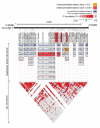Evidence for genetic association of RORB with bipolar disorder
- PMID: 19909500
- PMCID: PMC2780413
- DOI: 10.1186/1471-244X-9-70
Evidence for genetic association of RORB with bipolar disorder
Abstract
Background: Bipolar disorder, particularly in children, is characterized by rapid cycling and switching, making circadian clock genes plausible molecular underpinnings for bipolar disorder. We previously reported work establishing mice lacking the clock gene D-box binding protein (DBP) as a stress-reactive genetic animal model of bipolar disorder. Microarray studies revealed that expression of two closely related clock genes, RAR-related orphan receptors alpha (RORA) and beta (RORB), was altered in these mice. These retinoid-related receptors are involved in a number of pathways including neurogenesis, stress response, and modulation of circadian rhythms. Here we report association studies between bipolar disorder and single-nucleotide polymorphisms (SNPs) in RORA and RORB.
Methods: We genotyped 355 RORA and RORB SNPs in a pediatric cohort consisting of a family-based sample of 153 trios and an independent, non-overlapping case-control sample of 152 cases and 140 controls. Bipolar disorder in children and adolescents is characterized by increased stress reactivity and frequent episodes of shorter duration; thus our cohort provides a potentially enriched sample for identifying genes involved in cycling and switching.
Results: We report that four intronic RORB SNPs showed positive associations with the pediatric bipolar phenotype that survived Bonferroni correction for multiple comparisons in the case-control sample. Three RORB haplotype blocks implicating an additional 11 SNPs were also associated with the disease in the case-control sample. However, these significant associations were not replicated in the sample of trios. There was no evidence for association between pediatric bipolar disorder and any RORA SNPs or haplotype blocks after multiple-test correction. In addition, we found no strong evidence for association between the age-at-onset of bipolar disorder with any RORA or RORB SNPs.
Conclusion: Our findings suggest that clock genes in general and RORB in particular may be important candidates for further investigation in the search for the molecular basis of bipolar disorder.
Figures

Similar articles
-
Investigation of associations between NR1D1, RORA and RORB genes and bipolar disorder.PLoS One. 2015 Mar 19;10(3):e0121245. doi: 10.1371/journal.pone.0121245. eCollection 2015. PLoS One. 2015. PMID: 25789810 Free PMC article.
-
Circadian genes and lithium response in bipolar disorders: associations with PPARGC1A (PGC-1α) and RORA.Genes Brain Behav. 2016 Sep;15(7):660-8. doi: 10.1111/gbb.12306. Epub 2016 Aug 2. Genes Brain Behav. 2016. PMID: 27324142
-
RORA gene rs12912233 and rs880626 polymorphisms and their interaction with SCN1A rs3812718 in the risk of epilepsy: a case-control study in Malaysia.Genomics. 2015 Apr;105(4):229-36. doi: 10.1016/j.ygeno.2015.02.001. Epub 2015 Feb 7. Genomics. 2015. PMID: 25668517
-
[Circadian markers and genes in bipolar disorder].Encephale. 2015 Sep;41(4 Suppl 1):S38-44. doi: 10.1016/S0013-7006(15)30005-1. Encephale. 2015. PMID: 26746321 Review. French.
-
Circadian abnormalities as markers of susceptibility in bipolar disorders.Front Biosci (Schol Ed). 2014 Jan 1;6(1):120-37. doi: 10.2741/s419. Front Biosci (Schol Ed). 2014. PMID: 24389266 Review.
Cited by
-
Neuroplasticity, Neurotransmission and Brain-Related Genes in Major Depression and Bipolar Disorder: Focus on Treatment Outcomes in an Asiatic Sample.Adv Ther. 2018 Oct;35(10):1656-1670. doi: 10.1007/s12325-018-0781-2. Epub 2018 Sep 3. Adv Ther. 2018. PMID: 30178121 Free PMC article.
-
The role of sleep problems and circadian clock genes in childhood psychiatric disorders.J Neural Transm (Vienna). 2012 Oct;119(10):1097-104. doi: 10.1007/s00702-012-0834-7. Epub 2012 Jun 6. J Neural Transm (Vienna). 2012. PMID: 22669264 Review.
-
Discovery and validation of blood biomarkers for suicidality.Mol Psychiatry. 2013 Dec;18(12):1249-64. doi: 10.1038/mp.2013.95. Epub 2013 Aug 20. Mol Psychiatry. 2013. PMID: 23958961 Free PMC article.
-
Rare Case of a Heterozygous Microdeletion 9q21.11-q21.2: Clinical and Genetic Characteristics.Balkan J Med Genet. 2018 Dec 31;21(2):59-62. doi: 10.2478/bjmg-2018-0021. eCollection 2018 Dec. Balkan J Med Genet. 2018. PMID: 30984527 Free PMC article.
-
The best-laid plans go oft awry: synaptogenic growth factor signaling in neuropsychiatric disease.Front Synaptic Neurosci. 2014 Mar 18;6:4. doi: 10.3389/fnsyn.2014.00004. eCollection 2014. Front Synaptic Neurosci. 2014. PMID: 24672476 Free PMC article. Review.
References
-
- Geller B, Williams M, Zimerman B, Frazier J, Beringer L, Warner K. Prepubertal and early adolescent bipolarity differentiate from ADHD by manic symptoms, grandiose delusions, ultra-rapid or ultradian cycling. J Affect Disord. 1998;51:81–91. - PubMed
-
- Biederman J, Mick E, Faraone S, Van Patten S, Burback M, Wozniak J. A prospective follow up study of pediatric bipolar disorder in boys with attention deficit/hyperactivity disorder. J Affect Disord. 2004;82S:S17–S23. - PubMed
-
- Biederman J, Faraone S, Wozniak J, Mick E, Kwon A, Cayton G, Clark S. Clinical correlates of bipolar disorder in a large, referred sample of children and adolescents. J Psychiatr Res. 2005;39:611–622. - PubMed
-
- Luckenbaugh DA, Findling RL, Leverich GS, Pizzarello SM, Post RM. Earliest symptoms discriminating juvenile-onset bipolar illness from ADHD. Bipolar Disorders. 2009;11:441–451. - PubMed
-
- Bunney W, Bunney B. Molecular clock genes in man and lower animals: Possible implications for circadian abnormalities in depression. Neuropsychopharmacology. 2000;22(4):335–345. - PubMed

